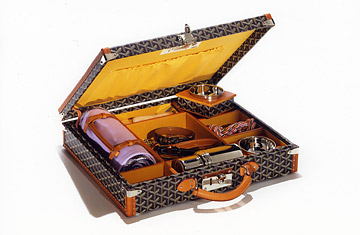
A dog trunk with a cover, brush, thermos, bowls and toys.
Most of Paris's luxury houses are busy chasing newer, younger, richer customers, but the venerable French luggage maker Goyard's latest project is all about reconnecting with its past. A new store across from the company's flagship on the Rue St.-Honoré in Paris, set to open in June, celebrates some of the company's oldest customers: pets.
At the turn-of-the century, the Parisian malletier grabbed medals at the World's Fairs in Paris and London for its handsome designs and supplied English Royals, Sarah Bernhardt and John Rockefeller with trunks. In 1892 Goyard opened a special department for "dogs, cats and monkeys" offering harnesses, kennels and booties among other items. Where else could an aristocratic Delahaye driver get his bulldog fitted for good-looking touring goggles?
There won't be any doggie goggles for sale at the "pets and picnic" annex (though custom orders are always possible). Instead, current best-sellers will be featured, including a hard case with water and food bowls, a leather French bulldog collar with a spiky badger ruff and the carrying case in the same chevron stamped canvas as the rest of the Goyard bags and luggage. Shoppers will also find the company's lavish 24-piece picnic trunk complete with sandwich and butter boxes and its 17,650 euro "Tea Time" trunks.
It's the latest in a string of new Goyard stores around the world since French entrepreneur Jean-Michel Signoles acquired the company from the family in 1998. The past two years have seen Goyard's fashion star soar among much larger and better financed European luxury brands. Japanese trendsetters snatch up giant rolling suitcases at Loveless in Tokyo and New Yorkers opt for the more portable tote bag. In Paris, if one can't afford to buy a bag (entry prices on popular models start at 510 euros for a medium-sized simple St Louis tote bag and 1470 euros for the Boeing weekend model) then you can always rent one for 25 euros a week online at www.sacdunjour.com . What suddenly ignited desires for Goyard's bags intrigues Goyard's competitors.
Certainly Signoles' decision, beginning in 2000, to scrap a newer material that had been substituted back in the Fifties and return to the house's traditional hemp, linen and cotton canvas material stamped with Goyard's signature chevron motif sent a strong message about reinforcing quality and authenticity at the company. New colors, including red, orange, gold and silver, perked up the windows. But neither move really explains the craze for the bags. And the company claims it wasn't really trying to create a hot fashion commodity.
"We don't want to be a fashion brand," insists Erich Hager, manager of the flagship Paris store. "We don't have collections. Occasionally we add a new design or a new color when it seems right." No advertising, just word of mouth plus a pedigree — a perfect formula for fashion trendsetters.
Upstairs above the store flattened totes fresh from the factory near Carcassonne in the southwest of France are stacked among hard suitcases and weathered vintage trunks, including a bulky number holding a polo player's gear. Many are stamped with the original owners' initials and a band of stripes in bright colors that recall jockey's colors or varsity jerseys from the Thirties. David Thomas, who consults on store design, points out a cluster of cases near the stairs stamped "The Duke of Windsor" and "The Duchess of Windsor" — his with red and yellow bands, hers striped yellow and blue. "They weren't just decorative," explains Thomas, pointing to the stripes and lettering. "The marks helped the servants pulling them off the train. Often they were numbered to help the maids find the right wardrobe."
Signoles discovered Goyard in 1974 when he bought his first vintage Goyard trunk and began collecting them. A native of the fortified medieval city of Carcassonne, Signoles founded and ran French fashion brand Chipie that was a hit with adolescents in the 1980s.
Unlike Signoles' fashion startup, the Goyard story stretched over generations. The first of the Goyards to get into the trunk business, François, moved to Paris with his family in 1832. For 200 years the family had been involved in floating logs up to Paris for firewood, and his father had decided to make a change. He apprenticed 17-year-old François to the house of Morel, a prominent packing case and trunk maker. On his death in 1853, Morel left Francois Goyard his business on the same site as the Goyard store today.
After four generations of running the business, including patents for a portable writing table and collaborations with leading automobile makers and Air France for innovative luggage, the Goyard family decided to sell and Signoles, who had built his collection to 600 trunks and had invested in the company, reached an agreement to buy Goyard.
"Goyard is first a trunk maker," said Signoles in an email. "Today there are only 2 brands that can claim a historic savoir-faire in this sector: Louis Vuitton and Goyard."